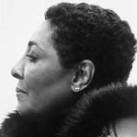
BIOGRAPHY
See and hear Carmen
Grove Dictionary
Miss Jazz
NY Times Obit
ESSAYS
Ralph Gleason
Carol Sloane
Hammond Guthrie
Interview by Art Taylor
Complete
List
of Original
Albums
Press
RECORDINGS
Overview
1940s,
50s
1960s
1960s, cont'd
1970s
1980s
1990s
CD
Starter Set
Film, Television, Radio
Friends and Fans
Sources
About us
Contact
November 12, 1994
Carmen McRae Is Dead at 74; Jazz Career Spanned 5 Decades
BY STEPHEN HOLDEN
Carmen McRae, the jazz singer known for her probing interpretations of lyrics and her bruised but unbowed point of view, died on Thursday evening at her home in Beverly Hills, Calif. She was 74. She had fallen into a semi-coma four days earlier, a month after being hospitalized for a stroke, said her secretary, Jan March. She withdrew from public performance in May 1991 after an episode of respiratory failure only hours after she completed an engagement at the Blue Note jazz club in New York.
Although Ms. McRae never reached the heights of popularity attained by Ella Fitzgerald, Sarah Vaughan and Billie Holiday, she was widely regarded as their artistic equal. In a prolific recording career that spanned nearly five decades, she had only two minor hits, both in the mid-1950's. But the scores of songs on she which stamped her bittersweet, gently mocking signature included "Alfie," "The Music That Makes Me Dance," "Guess Who I Saw Today?", "Blame It on My Youth," "Yesterdays" and "Mean to Me." In January, she received a National Endowment for the Arts Jazz Fellowship award for lifetime achievement.
Ms. McRae was born in Harlem on April 8, 1920, one of four [Ed. Note: she was an only child] children of immigrants from the West Indies. Growing up in Brooklyn, she attended Julia Richman High School in Manhattan and received her musical grounding in five years of formal piano lessons. Like many other jazz giants of her generation, she had her first break when she won an amateur talent contest at the Apollo Theater in Harlem. It was there that she was discovered in 1939 by Irene Kitchings, who was then married to the jazz pianist Teddy Wilson. Through Wilson, who worked with Billie Holiday, Ms. McRae met the woman who became her biggest influence and who recorded Ms. McRae's song "Dream of Life."
"If Billie Holiday had never existed," Ms. McRae later recalled, "I probably wouldn't have, either." Ms. McRae's parents, who opposed a show-business career, persuaded their daughter to take a secretarial course, and she spent two years in Washington doing clerical work for the Government. Returning to Brooklyn in 1943, she did office work by day while performing in clubs at night. Gradually music took over, and she began substituting for other singers in bands led by Benny Carter, Count Basie and Earl (Fatha) Hines. She eventually landed an 18-month engagement with a band led by Mercer Ellington, Duke's son, and in 1946 she made her recording debut with the band, singing under the name Carmen Clarke.
In Chicago, when the Ellington band broke up, Ms. McRae remained there and embarked on a solo career. A two-week engagement in a club as a singing pianist expanded to 17 weeks, and she ended up staying in Chicago three and a half years. Her career took off when she returned to New York and developed an act as a stand-up singer at Minton's Playhouse in Harlem, receiving enough notice to be named best new female singer by Down Beat magazine.
Ms. McRae released her first solo album for Bethlehem in 1955, the same year she made her first recordings for Decca, where she remained until 1958. From there she moved to Kapp (1958-60) and Columbia (1960-62), then jumped to several smaller labels before ending up on Atlantic for five years (1967-71). Her longest record company affiliation was with Concord Jazz (1980-88). Her last two albums, for RCA, were tributes to Thelonious Monk and Sarah Vaughan.
In these four decades as a jazz star, Ms. McRae toured constantly. Although she left New York for Southern California in the late 1960's, she appeared in New York regularly, usually at the Blue Note, where she did two engagements a year through most of the 1980's.
From the moment she made her mark, Ms. McRae was recognized as a supremely insightful interpreter of lyrics.
"Every word is very important to me," she said. "Lyrics come first, then the melody. The lyric of a song I might decide to sing must have something that I can convince you with. It's like an actress who selects a role that contains something she wants to portray."
The singer's two marriages, to the be-bop drummer Kenny Clarke and the
pianist [bassist] Ike Isaacs, both ended in divorce. There was no immediate
word on survivors.








